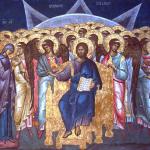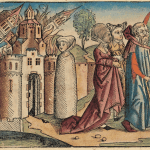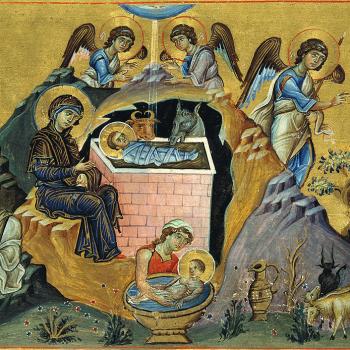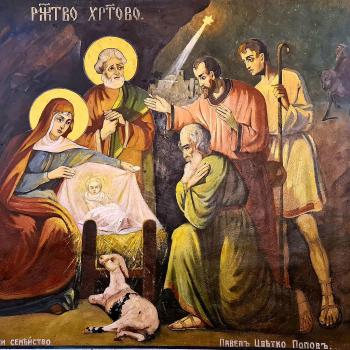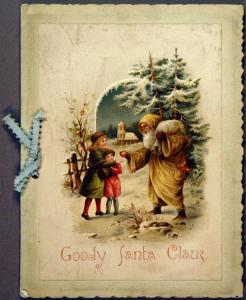 “I don’t tell my children about Santa Clause. I don’t want to lie to them.”
“I don’t tell my children about Santa Clause. I don’t want to lie to them.”
This is what many tell me when they explain why they do not tell their children about Santa Claus. It saddens me to see so many seek to remove the great modern myth from our heritage; while they might do so with the best of intentions, they remove a part of the joy which children around the world experience during the Christmas season.
While some truly think telling their children the story of Santa would be the same as lying to them, others are lying to themselves and others as they use this excuse to justify their own selfishness, as they feel they would not have to buy as many presents for their children. They are Scrooges who know nothing of the spirit of Christmas and they threaten to make their children just like them.
The truth of the matter is that it is not a lie to tell the story of Santa Claus, nor are parents lying to their children when they give gifts to their children in the guise of Santa. While there are many variations of the story, Santa Claus is a myth, and like all myths, it is false to call it a lie: myths are not lies, as J.R.R. Tolkien once told C.S. Lewis; rather they present a different, often poetic, engagement with the world at large.[1] Lewis, then, would come to agree: myths are not lies; they are not fictions, for they give a representation of reality in a form which differs from the way modern positivistic philosophy tries to confine it. It is not mere abstraction as found in mathematics, but rather, is the invasion of a truth which transcends such thought which looks especially for particular examples or facts:
To explain this we must look a little closer at myth in general, and at this myth in particular. Human intellect is incurably abstract. Pure mathematics is the type of successful thought. Yet the only realities we experience are concrete – this pain, this pleasure, this dog, this man. While we are loving the man, bearing the pain, enjoying the pleasure, we are not intellectually apprehending Pleasure, Pain or Personality. When we begin to do so, on the other hand, the concrete realities sink to the level of mere instances or examples: we are no longer dealing with them, but with that which they exemplify.[2]
When we go to the level of myth, of storytelling, we go beyond mere abstractions, beyond mere thought and encounter reality which then is translated and expressed in a variety of ways; a variety of facts, when combined, could not grasp the myth but only reveal various notions which we can receive from it:
When we translate we get abstraction ‐ or rather, dozens of abstractions. What flows into you from the myth is not truth but reality (truth is always about something, but reality is that about which truth is), and, therefore, every myth becomes the father of innumerable truths on the abstract level. Myth is the mountain whence all the different streams arise which become truths down here in the valley; in hac valle abstractionis. Or, if you prefer, myth is the isthmus which connects the peninsular world of thought with that vast continent we really belong to. It is not, like truth, abstract; nor is it, like direct experience, bound to the particular.[3]
Santa Claus is one of the great modern myths; the fact that it has come from and developed from many other myths and historical sources (Saint Nicholas, Odin, et. al.) does it no harm. The story, the myth, is one which tells us much about the nature of reality, of the transcendence of charity, and the relationship of grace with nature by showing how we are to cooperate with grace in order to receive its bounty. Those who do good will be rewarded in a way beyond their goodness; those who stray and do evil cut themselves from grace and face the consequences of their straying (such as having bad children find coal in their stockings). It is not, as some would think, a capitalistic myth (though capitalists can and do use it), because it is about giving to the poor and needy, and bringing cheer to all despite their wealth. The goods which are given are not bought but are given out; those who labor share the results of their labor with all, and do not hold on to it themselves, hoarding the goods which they have created as capital.
The story, the myth, is not a lie; it is not to be seen as history or some positivistic abstraction of what is thought to be true, but rather, it presents to us reality coming to us, revealing to us itself in a way which we form such notions of truth, allowing us to realize the greatness of the truth itself. We are able to be emotionally challenged and moved by the way myths are told, having us interact with the myth in a way that dull presentations of the facts are unable to do. Telling the story of Santa is sharing in the grand story, and only when we try to interpret it in a way which goes against the truth does such an allegorical use of the story turn out to be false: but bad allegory does not make the story false, only it makes those trying to abstract meaning from it in error.
Likewise, participating in that story is telling it, and because myths are not lies, telling them and acting them out cannot be seen to be lies. The story is presented in a way which requires more than words. When parents leave gifts out late at night when their children are asleep, they are continuing with the story. When they tell their children in the morning that the gifts were given by Santa, they are not lying; they are only continuing with the storytelling. Likewise, when children see the presents, hey know they have not being lied to: someone came and gave them gifts, and that someone is named Santa. It is the name and convention used to explain the whole phenomenon, a phenomenon which truly happens while the children are asleep. The parents who give such gifts are participating in the reality of the Santa myth, becoming a part of it, acting it out, so that the story is properly told and the reality of story is realized by the children who hear it told. By acting out the part of Santa, they are partaking of the reality expressed and revealed in the myth, sharing with it, becoming one with it. How can they be said to be lying when the story is not a falsehood, and there are truly gifts which are given, expressed by the convention of Santa? They are not. The children received the gifts. They saw the reality become expressed in particular facts, even as the greatest myth is realized and made concrete as the central fact of history (the story of God becoming man realized in the birth of the God-man Jesus Christ). They experience the story, the myth, indeed, the reality presented by the myth: they might not know the role their parents play in the realization of the myth, but the children see the reality of the myth, as they experience the phenomena of Santa in their lives and wake up on Christmas morning seeing the gifts which have been left behind.
“But it is a lie. Parents are not Santa.” Really? They certainly are Santa. That’s the point. The phenomenon happens – the gifts are left behind. The phenomenon is known as Santa. Those who give the gifts, those who take on the role of Santa, truly become Santa, partaking of the reality of the myth and so they truly are Santa, even as anyone who holds a particular job can be called by the title of that job, or someone wearing a mask can be called by the name of the figure in the mask. They are Santa, and they did not lie: Santa did come, and he gave gifts. The phenomenon has the conventional name of Santa; the underlying reality of that phenomenon is that it is parents who give such gifts, and the truth then is that the parents, who are Santa, gave gifts, so there is no lie. The only lie is from those who deny Santa: for how can someone explain the gifts which are given, which children can and do see with their own eye?
The phenomenon children experience on Christmas is given the conventional name of Santa. That phenomenon happens; it is true. The underlying nature of how Santa is realized is that parents partake of the role of Santa, and so make the phenomenon real. They did not lie. Likewise, it is true, they are not purely Santa: they are their children’s parents: Santa is, as with all such abstractions, capable of being true because of it is empty of any inherent nature, allowing therefore, as many forms of the phenomenon to appear as there are people giving gifts in the role of Santa.
Santa is real. Let’s stop telling the lie that there is no Santa. Let the children rejoice and let all good parents be satisfied in the good which they do for their children. Scrooge needs to be put to rest, so that in the night, he can experience that joy and come around wishing everyone Merry Christmas, never again saying “Humbug” to the reality of Santa.
[IMG=Cover of “Goody Santa Claus” dated 1889. by RL [Public domain], via Wikimedia Commons]
[1] Tolkien wrote his poem, Mythopoeia, for Lewis when Lewis was still an unbeliever; in it, Tolkien explained:
“The heart of man is not compound of lies,
but draws some wisdom from the only Wise.”
Myths present the world in a manner and style different from science or mathematics, but this does not make them any less true, any less informative for those who know how to engage them. They are not lies. They are a means by which we engage the greater reality, a reality which transcends the categories which we use to explain it.
[2] C.S. Lewis, “Myth Became Fact” in Undeceptions. Ed. Walter Hooper (London: Geoffrey Bles, 1971), 41.
[3] Ibd., 42.
Stay in touch! Like A Little Bit of Nothing on Facebook


